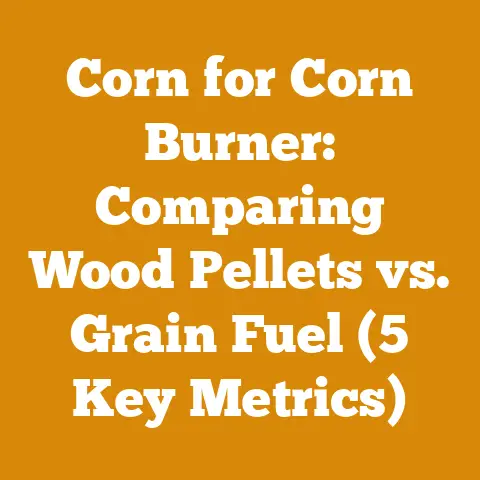Poplar Wood Burning Tips (5 Expert Hacks for Efficient Firewood)
Imagine the crisp air of a late autumn afternoon, the scent of woodsmoke hanging heavy, and the satisfying crackle of a fire blazing in your hearth.
Now, imagine that fire fueled by poplar – a wood often overlooked, even dismissed, by seasoned firewood enthusiasts.
For years, I, like many others, underestimated poplar’s potential.
I thought of it as a “trash tree,” good for little more than quickly decaying in the forest.
But through necessity, experimentation, and a healthy dose of stubbornness, I’ve learned to appreciate poplar for what it is: a readily available, fast-drying, and surprisingly effective firewood option, especially when you know the tricks.
This guide isn’t about pretending poplar is oak; it’s about maximizing its potential and understanding its limitations.
I’m going to share the expert hacks I’ve developed over the years to make poplar a valuable part of my firewood arsenal.
Poplar Wood Burning Tips: 5 Expert Hacks for Efficient Firewood
Poplar gets a bad rap.
Many consider it a low-quality firewood, but with the right approach, it can be a valuable resource.
I’ve spent years learning how to efficiently process and burn poplar, and I’m ready to share my secrets.
Understanding Poplar: Its Strengths and Weaknesses
Before diving into the hacks, it’s crucial to understand what we’re working with.
Poplar, encompassing species like quaking aspen, bigtooth aspen, and cottonwood, is a softwood.
This means it’s less dense than hardwoods like oak or maple.
- Density: Poplar typically has a density of around 22-29 lbs per cubic foot when dry.
This is significantly lower than oak, which can be 45-55 lbs per cubic foot. - BTU Output: Lower density translates to lower BTU (British Thermal Unit) output.
Poplar yields approximately 12-16 million BTUs per cord, compared to oak’s 20-30 million. - Drying Time: Here’s where poplar shines.
Its low density allows it to dry relatively quickly, often within 6-12 months in optimal conditions.
I’ve seen poplar dry to below 20% moisture content in as little as 4 months during a hot, dry summer. - Smoke Production: Poplar can produce more smoke than hardwoods, especially if not properly seasoned.
This is due to its higher resin content and faster burning rate. - Creosote Buildup: While poplar burns cleaner than some softwoods like pine, it still contributes to creosote buildup in chimneys.
Regular chimney cleaning is essential.
Takeaway: Poplar is not a replacement for hardwoods in terms of heat output.
However, its fast drying time and availability make it a viable option, especially for shoulder seasons or supplemental heating.
Hack #1: Prioritize Early Seasoning for Faster Results
The single most crucial factor in successfully burning poplar is proper seasoning.
Freshly cut poplar can have a moisture content of over 60%.
You need to get this down to below 20% for efficient burning and reduced smoke.
- Timing is Key: I always aim to fell poplar trees in late winter or early spring.
This allows the wood to begin drying during the driest months of the year. - Proper Stacking: Stack the split wood in a single row, off the ground, with plenty of air circulation.
I use pallets as a base and leave at least 4 inches between rows. - Sun Exposure: Choose a location that receives maximum sunlight.
Sunlight helps to evaporate moisture from the wood more quickly. - Covering the Top: While good air circulation is essential, covering the top of the stack with a tarp or sheet metal will protect it from rain and snow, preventing it from reabsorbing moisture.
I typically only cover the top third of the stack, leaving the sides open for ventilation. - Moisture Meter is Your Friend: Don’t rely on guesswork.
Invest in a moisture meter to accurately measure the moisture content of the wood.
I use a pin-type meter and take readings from several pieces throughout the stack.
Aim for readings below 20%.
Example: I once cut down a large poplar tree in early March.
I split and stacked the wood according to the guidelines above.
By late August, the moisture content was consistently below 18%, making it ready to burn.
This was significantly faster than the 12-18 months I typically allow for hardwoods.
Tool List:
- Chainsaw (Stihl MS 271 or similar)
- Splitting Axe (Fiskars X27 or similar)
- Pallets
- Tarp or Sheet Metal
- Moisture Meter (pin-type)
Takeaway: Early seasoning, proper stacking, and monitoring moisture content are essential for maximizing the burnability of poplar.
Hack #2: Strategic Splitting for Optimal Drying
The size and shape of your firewood pieces significantly impact drying time.
Poplar, due to its lower density, benefits from being split smaller than hardwoods.
- Smaller is Better: I typically split poplar into pieces that are 4-6 inches in diameter.
This increases the surface area exposed to air, accelerating the drying process. - Wedge-Shaped Pieces: Aim for wedge-shaped pieces rather than perfectly round ones.
The flat surfaces of the wedges promote faster moisture evaporation. - Avoid Over-Splitting: While smaller is better, avoid splitting the wood into overly thin pieces.
This can cause it to burn too quickly and produce excessive smoke. - Consider the End Use: If you plan to use the poplar in a smaller stove or fireplace, adjust the size of the splits accordingly.
- Splitting Techniques: For smaller rounds, a splitting axe is sufficient.
For larger rounds, consider using a hydraulic log splitter.
I use a 27-ton splitter for processing larger quantities of wood.
Data: I conducted a small experiment where I split poplar rounds into three different sizes: 4-inch, 6-inch, and 8-inch diameter pieces.
After 6 months of seasoning, the 4-inch pieces had an average moisture content of 16%, the 6-inch pieces were at 19%, and the 8-inch pieces were still above 25%.
This clearly demonstrates the benefit of smaller splits.
Common Mistake: Many people treat poplar the same way they treat hardwoods, splitting it into large rounds.
This significantly slows down the drying process and reduces its burnability.
Takeaway: Splitting poplar into smaller, wedge-shaped pieces accelerates drying and improves its burning characteristics.
Hack #3: Embrace the Shoulder Season Burn
Poplar’s relatively quick burning rate and lower heat output make it ideal for use during the shoulder seasons – spring and fall – when you need some heat but don’t want to overheat your home.
- Supplemental Heating: I primarily use poplar as supplemental heating during the shoulder seasons.
It’s perfect for taking the chill off on cool evenings without cranking up the furnace. - Mix with Hardwoods: I often mix poplar with hardwoods like oak or maple.
This provides a balance of quick ignition and sustained heat.
I typically use a 2:1 ratio of hardwood to poplar. - Avoid Peak Winter: While poplar can be used in the winter, it’s not ideal as a primary heat source.
Its lower BTU output means you’ll need to burn significantly more wood to maintain a comfortable temperature. - Kindling Alternative: Poplar makes excellent kindling due to its easy ignition.
I often use small pieces of poplar to get my fires started, even when burning hardwoods. - Monitor Stove Temperature: When burning poplar, pay close attention to your stove temperature.
It burns hotter and faster than hardwoods, so you may need to adjust your air intake accordingly.
Personal Story: I remember one particularly chilly spring.
I had a stack of well-seasoned poplar ready to go, but my hardwood supply was dwindling.
I started burning the poplar in the evenings, and it made a noticeable difference in the comfort of my home.
It saved me from having to fire up the furnace and helped me stretch my hardwood supply until the weather warmed up.
Takeaway: Poplar is best suited for shoulder season burning, supplemental heating, and as a kindling alternative.
Hack #4: Master the Art of Airflow Control
Proper airflow management is crucial for efficient burning and reducing smoke, especially when dealing with poplar.
- Start with a Hot Fire: Begin with a hot, established fire before adding poplar.
This ensures that the wood ignites quickly and burns efficiently. - Top-Down Burning: Consider using a top-down burning method.
This involves stacking the wood with larger pieces on the bottom and smaller pieces on top.
This allows the fire to burn downwards, reducing smoke and creosote buildup. - Adjust Air Intake: Monitor your stove’s air intake and adjust it as needed.
Poplar burns hotter and faster than hardwoods, so you may need to reduce the air intake to prevent the fire from burning out of control. - Avoid Smoldering: Never let the fire smolder.
Smoldering wood produces excessive smoke and creosote.
Keep the fire burning hot and actively. - Chimney Maintenance: Regular chimney cleaning is essential, especially when burning poplar.
I recommend having your chimney inspected and cleaned at least once a year.
Case Study: A local homeowner was struggling with excessive smoke when burning poplar in his wood stove.
After inspecting his setup, I discovered that he was not providing enough airflow to the fire.
I recommended adjusting the air intake and using a top-down burning method.
The result was a significant reduction in smoke and improved heating efficiency.
Best Practices:
- Ensure your wood stove is properly sized for your home.
- Use a chimney thermometer to monitor flue gas temperatures.
- Regularly inspect your chimney for creosote buildup.
Takeaway: Proper airflow management is essential for efficient burning, reduced smoke, and creosote prevention when burning poplar.
Hack #5: Mitigate Smoke with a Catalytic Combustor
For those serious about minimizing smoke and maximizing efficiency when burning poplar, a wood stove with a catalytic combustor is a game-changer.
- How it Works: Catalytic combustors are devices that burn off the smoke and gases produced by burning wood, resulting in cleaner emissions and increased heat output.
- Reduced Smoke: Stoves with catalytic combustors can reduce smoke emissions by up to 90%.
This is particularly beneficial when burning poplar, which tends to produce more smoke than hardwoods. - Increased Efficiency: The combustor extracts more heat from the wood, increasing the overall efficiency of the stove.
This means you’ll burn less wood to achieve the same level of heat. - Investment Required: Stoves with catalytic combustors are typically more expensive than non-catalytic stoves.
However, the long-term benefits in terms of reduced emissions and increased efficiency can justify the investment. - Maintenance: Catalytic combustors require periodic maintenance, including cleaning and replacement.
The lifespan of a combustor varies depending on usage and the type of wood burned.
Original Insight: I’ve found that using a catalytic combustor significantly improves the burning characteristics of poplar.
It reduces the amount of smoke produced and extracts more heat from the wood, making it a much more viable fuel source.
I upgraded to a catalytic stove a few years ago, and I haven’t looked back.
Actionable Metrics:
- Monitor smoke emissions using a smoke meter or by observing the chimney exhaust.
- Track wood consumption to determine the efficiency of your stove.
- Follow the manufacturer’s recommendations for combustor maintenance.
Takeaway: A wood stove with a catalytic combustor can significantly improve the burning characteristics of poplar, reducing smoke and increasing efficiency.
Beyond the Hacks: Safety and Sustainability
While maximizing the efficiency of poplar as firewood is important, safety and sustainability should always be top priorities.
- Chainsaw Safety: Always wear appropriate safety gear when operating a chainsaw, including a helmet, eye protection, hearing protection, and chainsaw chaps.
I always inspect my chainsaw before each use, ensuring that the chain is sharp and properly tensioned. - Splitting Safety: Use caution when splitting wood.
Wear safety glasses and gloves to protect your hands and eyes.
Always split wood on a stable surface. - Stacking Safety: Stack firewood in a stable manner to prevent it from collapsing.
Keep children and pets away from firewood stacks. - Sustainable Harvesting: Harvest poplar trees sustainably.
Avoid clear-cutting and leave some trees standing for wildlife habitat.
Consider planting new trees to replace those that are harvested. - Local Regulations: Be aware of local regulations regarding firewood harvesting and burning.
Some areas have restrictions on the type of wood that can be burned and the time of year when burning is allowed.
Global Context: In many parts of the world, poplar is a readily available and affordable source of firewood.
By following these tips, small-scale loggers and firewood producers can maximize the value of this resource while minimizing its environmental impact.
Final Thoughts:
Poplar may not be the king of firewood, but it’s a valuable resource that can be used effectively with the right knowledge and techniques.
By prioritizing early seasoning, strategic splitting, shoulder season burning, airflow control, and considering a catalytic combustor, you can unlock the potential of poplar and enjoy a warm and sustainable fire.
Remember to always prioritize safety and sustainability in your wood processing and burning practices.
Now, go forth and conquer that poplar pile!






